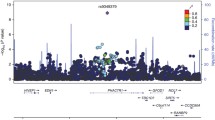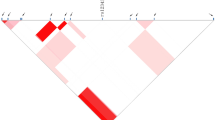Abstract
Spontaneous cervico-cerebral artery dissection (CCAD) is a common condition found among young patients with ischemic stroke. We examined the possible association between the polymorphism of methylenetetrahydrofolate reductase (MTHFR)-C677T and the gene mutation in transforming growth factor beta receptor II (TGFBR2) in a cohort of CCAD patients. One-hundred CCAD cases (65 males; mean age: 38.08 ± 10.68 years) and 100 matching controls were included. Ancestry informative markers (AIMs) were used to increase internal validity of the genetic analysis. Genotypes of the C677T polymorphism in the MTHFR gene were determined by polymerase chain reaction and restriction fragment length polymorphism; direct sequencing was used for a mutation analysis of the TGFBR2 gene. Associations were evaluated using a multivariate statistics, and Hardy–Weinberg equilibrium was analyzed. We also incorporated our data into a meta-analysis of the MTHFR-C677T. Sixty-three patients presented with vertebral and 37 with carotid artery dissection. Ancestry markers found a call rate on each over 95 %. All AIMs did not deviate from Hardy–Weinberg equilibrium (p > 0.05). The homozygous TT genotype was more frequent in cases (OR 2.04, CI 95 % 1.53–2.72, p = 0.005), whereas no significant difference was found on heterozygous CT genotype. TGFBR2 mutation was not present in our samples. In the meta-analysis of MTHFR/C677T variant, a total 613 cases and 1547 controls were analyzed; we found a moderate association for the recessive model genotype (OR 2.04, CI 95 % 1.53–2.72; p = 0.342; Z = 4.83; I 2 = 11.3). This study supports a positive association between the MTHFR-C677T polymorphism and genetically confirmed Mexican mestizo CCAD patients.


Similar content being viewed by others
References
Putaala J, Metso AJ, Metso TM et al (2009) Analysis of 1008 consecutive patients aged 15–49 with first-ever ischemic stroke: the Helsinki young stroke registry. Stroke 40:1195–1203
Debette S, Leys D (2009) Cervical-artery dissections: predisposing factors, diagnosis, and outcome. Lancet Neurol 8:668–678
Schievink WI (2001) Spontaneous dissection of the carotid and vertebral arteries. N Engl J Med 344:898–906
Barinagarrementeria F, Figueroa T, Huebe J et al (1996) Cerebral infarction in people under 40 years: etiologic analysis of 300 cases prospectively evaluated. Cerebrovasc Dis 6:75–79
Germain DP (2007) Ehlers-Danlos syndrome type IV. Orphanet J Rare Dis 2:32
Rodrigues VJ, Elsayed S, Loeys BL et al (2009) Neuroradiologic manifestations of Loeys-Dietz syndrome type 1. Am J Neuroradiol 30:1614–1619
Brandt T, Orberk E, Weber R et al (2001) Pathogenesis of cervical artery dissections: association with connective tissue abnormalities. Neurology 57:24–30
Debette S, Markus HS (2009) The genetics of cervical artery dissection: a systematic review. Stroke 40:e459–e466
Wiest T, Hyrenbach S, Bambul P et al (2006) Genetic analysis of familial connective tissue alterations associated with cervical artery dissections suggests locus heterogeneity. Stroke 37:1697–1702
Debette S (2014) Pathophysiology and risk factors of cervical artery dissection: what have we learnt from large hospital-based cohorts? Curr Opin Neurol 27:20–28
Pezzini A, Drera B, Del Zotto E et al (2011) Mutations in TGFBR2 gene cause spontaneous cervical artery dissection. J Neurol Neurosurg Psychiatry 82:1372–1374
Jara-Prado A, Alonso ME, Martinez Ruano L et al (2010) MTHFR C677T, FII G20210A, FV Leiden G1691A, NOS3 intron 4 VNTR, and APOE epsilon4 gene polymorphisms are not associated with spontaneous cervical artery dissection. Int J Stroke 58:80–85
Arauz A, Hoyos L, Cantu C et al (2007) Mild hyperhomocysteinemia and low folate concentrations as risk factors for cervical arterial dissection. Cerebrovasc Dis 24:210–214
Gaughan DJ, Barbaux S, Kluijtmans LA et al (2000) The human and mouse methylenetetrahydrofolate reductase (MTHFR) genes: genomic organization, mRNA structure and linkage to the CLCN6 gene. Gene 257:279–289
Pezzini A, Del Zotto E, Archetti S et al (2002) Plasma homocysteine concentration, C677T MTHFR genotype, and 844ins68 bp CBS genotype in young adults with spontaneous cervical artery dissection and atherothrombotic stroke. Stroke 33:664–669
Chobanian AV, Bakris GL, Black HR et al (2003) Seventh report of the Joint National Committee on prevention, detection, evaluation, and treatment of high blood pressure. Hypertension 42:1206–1252
Lepor NE, Vogel RE (2001) National Cholesterol Education Program Adult Treatment Panel III. Summary of the third report of the National Cholesterol Education Program Adult Treatment Panel III. Rev Cardiovasc Med 2:160–165
Gil-Velázquez LE, Sil-Acosta MJ, Domínguez-Sánchez ER et al (2013) Practice guideline. Diagnosis and treatment of type 2 diabetes mellitus. Rev Med Inst Mex Seguro Soc 51:104–119
Bamford J, Sandercock P, Dennis M et al (1991) Classification and natural history of clinically subtypes of cerebral infarction. Lancet 337:1521–1526
Vertinsky AT, Schwartz NE, Fischbein NJ et al (2008) Comparison of multidetector CT angiography and MR imaging of cervical artery dissection. Am J Neuroradiol 29:1753–1760
Rodallec MH, Marteau V, Gerber S et al (2008) Craniocervical arterial dissection: spectrum of imaging findings and differential diagnosis. Radiographics 28:1711–1728
Debette S, Grond-Ginsbach C, Bodenant M et al (2011) Differential features of carotid and vertebral artery dissections. The CCADISP study. Neurology 77:1174–1181
Thomas LC, Rivett DA, Parsons M et al (2014) Risk factors, radiological features, and infarct topography of craniocervical arterial dissection. Int J Stroke 9:1073–1082
Miller SA, Dykes DD, Polesky HF (1988) A simple salting out procedure for extracting DNA from human nucleated cells. Nucleic Acids Res 16:1215
Villalobos-Comparán M, Teresa Flores-Dorantes M, Teresa Villarreal-Molina M et al (2008) The FTO gene is associated with adulthood obesity in the Mexican population. Obesity (Silver Spring) 16:2296–2301
Frosst P, Blom HJ, Milos R et al (1995) A candidate genetic risk factor for vascular disease: a common mutation in methylenetetrahydrofolate reductase. Nat Genet 10:111–113
Luo H, Liu B, Hu J et al (2014) Hyperhomocysteinemia and methylenetetrahydrofolate reductase polymorphism in cervical artery dissection: a meta-analysis. Cerebrovasc Dis 37:313–322
Gallai V, Caso V, Paciaroni M et al (2001) Mild hyperhomocyst(e)inemia: a possible risk factor for cervical artery dissection. Stroke 32:714–718
Konrad C, Muller GA, Langer C et al (2004) Plasma homocysteine, MTHFR C677T, CBS 844ins68 bp, and MTHFD1 G1958A polymorphisms in spontaneous cervical artery dissections. J Neurol 251:1242–1248
Kloss M, Wiest T, Hyrenbach S et al (2006) MTHFR 677TT genotype increases the risk for cervical artery dissections. J Neurol Neurosurg Psychiatry 77:951–952
Pezzini A, Grassi M, Del Zotto E et al (2007) Migraine mediates the influence of C677T MTHFR genotypes on ischemic stroke risk with a stroke-subtype effect. Stroke 38:3145–3151
Longoni M, Grond-Ginsbach C, Grau AJ et al (2006) The ICAM-1 E469K gene polymorphism is a risk factor for spontaneous cervical artery dissection. Neurology 66:1273–1275
von Pein F, Valkkila M, Schwarz R et al (2002) Analysis of the COL3A1 gene in patients with spontaneous cervical artery dissections. J Neurol 249:862–866
Martin JJ, Hausser I, Lyrer P et al (2006) Familial cervical artery dissections: clinical, morphologic, and genetic studies. Stroke 37:2924–2929
Kuivaniemi H, Prockop DJ, Wu Y et al (1993) Exclusion of mutations in the gene for type III collagen (COL3A1) as a common cause of intracranial aneurysms or cervical artery dissections: results from sequence analysis of the coding sequences of type III collagen from 55 unrelated patients. Neurology 43:2652–2658
Debette S, Kamatani Y, Metso TM et al (2015) Common variation in PHACTR1 is associated with susceptibility to cervical artery dissection. Nat Genet 47:78–83
Graham IM, Daly LE, Refsum HM et al (1997) Plasma homocysteine as a risk factor for vascular disease: the European Concerted Action Project. JAMA 277:1775–1781
Dayal S, Wilson KM, Leo L et al (2006) Enhanced susceptibility to arterial thrombosis in a murine model of hyperhomocysteinemia. Blood 108:2237–2243
Lentz SR (1997) Homocysteine and vascular dysfunction. Life Sci 61:1205–1215
Fassbender K, Mielke O, Bertsch T et al (1999) Homocysteine in cerebral macroangiography and microangiopathy. Lancet 353:1586–1587
Charpiot P, Bescond A, Augier T et al (1998) Hyperhomocysteinemia induces elastolysis in minipig arteries: structural consequences, arterial site specificity and effect of captoprilhydrochlorothiazide. Matrix Biol 17:559–574
Rahmani DJ, Rolland PH, Rosset E et al (1997) Homocysteine induces synthesis of a serine elastase in arterial smooth muscle cells from multi-organ donors. Cardiovasc Res 34:597–602
Brandt T, Hausser I, Orberk E et al (1998) Ultrastructural connective tissue abnormalities in patients with spontaneous cervicocerebral artery dissections. Ann Neurol 44:281–285
Tian C, Gregersen PK, Seldin MF (2008) Accounting for ancestry: population substructure and genome-wide association studies. Hum Mol Genet 17:R143–R150
Author information
Authors and Affiliations
Corresponding author
Ethics declarations
Conflicts of interest
Dr. Ruiz-Franco reported no conflict of interest disclosure. Dr. Barboza reported no conflict of interest disclosure. Dr. Jara-Prado reported no conflict of interest disclosure. Dr. Canizales-Quinteros reported no conflict of interest disclosure. Dr. Leon-Mimila reported no conflict of interest disclosure. Dr. Arguelles-Morales reported no conflict of interest disclosure. Dr. Vargas-González reported no conflict of interest disclosure. Dr. Quiroz-Compean reported no conflict of interest disclosure. Dr. Arauz had served as a research adviser for Boehringer-Ingelheim and Pfizer.
Funding/support
This research was partially supported by the Centro Nacional de Ciencia y Tecnología (CONACYT) FONSEC 181359 Educational Grant in México.
Rights and permissions
About this article
Cite this article
Ruiz-Franco, A., Barboza, M.A., Jara-Prado, A. et al. TGFBR2 mutation and MTHFR-C677T polymorphism in a Mexican mestizo population with cervico-cerebral artery dissection. J Neurol 263, 1066–1073 (2016). https://doi.org/10.1007/s00415-016-8101-8
Received:
Revised:
Accepted:
Published:
Issue Date:
DOI: https://doi.org/10.1007/s00415-016-8101-8




